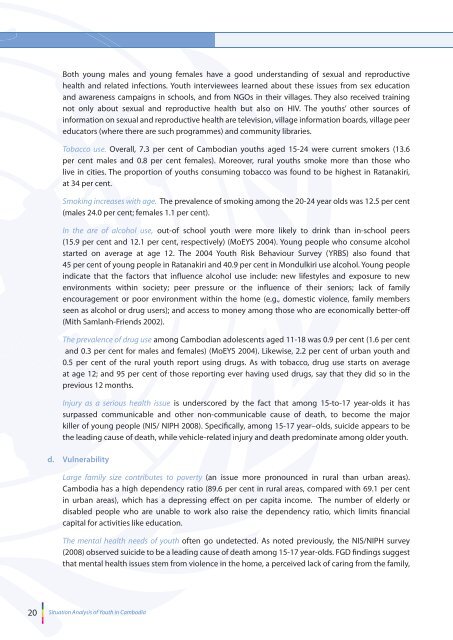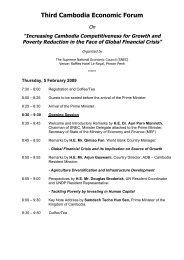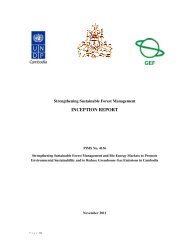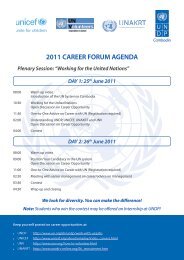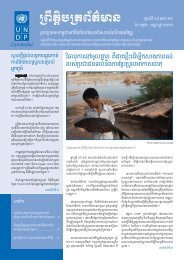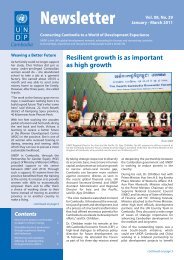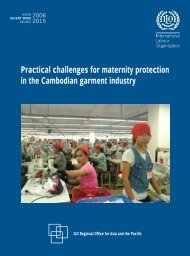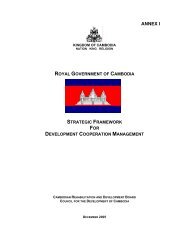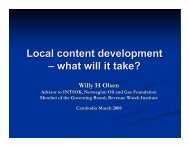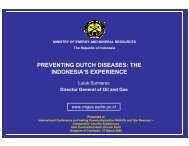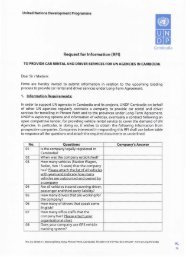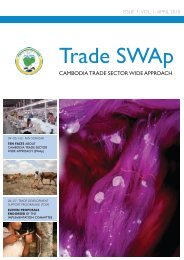UN Analysis Final.pdf - United Nations in Cambodia
UN Analysis Final.pdf - United Nations in Cambodia
UN Analysis Final.pdf - United Nations in Cambodia
Create successful ePaper yourself
Turn your PDF publications into a flip-book with our unique Google optimized e-Paper software.
Both young males and young females have a good understand<strong>in</strong>g of sexual and reproductive<br />
health and related <strong>in</strong>fections. Youth <strong>in</strong>terviewees learned about these issues from sex education<br />
and awareness campaigns <strong>in</strong> schools, and from NGOs <strong>in</strong> their villages. They also received tra<strong>in</strong><strong>in</strong>g<br />
not only about sexual and reproductive health but also on HIV. The youths’ other sources of<br />
<strong>in</strong>formation on sexual and reproductive health are television, village <strong>in</strong>formation boards, village peer<br />
educators (where there are such programmes) and community libraries.<br />
Tobacco use. Overall, 7.3 per cent of <strong>Cambodia</strong>n youths aged 15-24 were current smokers (13.6<br />
per cent males and 0.8 per cent females). Moreover, rural youths smoke more than those who<br />
live <strong>in</strong> cities. The proportion of youths consum<strong>in</strong>g tobacco was found to be highest <strong>in</strong> Ratanakiri,<br />
at 34 per cent.<br />
Smok<strong>in</strong>g <strong>in</strong>creases with age. The prevalence of smok<strong>in</strong>g among the 20-24 year olds was 12.5 per cent<br />
(males 24.0 per cent; females 1.1 per cent).<br />
In the are of alcohol use, out-of school youth were more likely to dr<strong>in</strong>k than <strong>in</strong>-school peers<br />
(15.9 per cent and 12.1 per cent, respectively) (MoEYS 2004). Young people who consume alcohol<br />
started on average at age 12. The 2004 Youth Risk Behaviour Survey (YRBS) also found that<br />
45 per cent of young people <strong>in</strong> Ratanakiri and 40.9 per cent <strong>in</strong> Mondulkiri use alcohol. Young people<br />
<strong>in</strong>dicate that the factors that <strong>in</strong>fluence alcohol use <strong>in</strong>clude: new lifestyles and exposure to new<br />
environments with<strong>in</strong> society; peer pressure or the <strong>in</strong>fluence of their seniors; lack of family<br />
encouragement or poor environment with<strong>in</strong> the home (e.g., domestic violence, family members<br />
seen as alcohol or drug users); and access to money among those who are economically better-off<br />
(Mith Samlanh-Friends 2002).<br />
The prevalence of drug use among <strong>Cambodia</strong>n adolescents aged 11-18 was 0.9 per cent (1.6 per cent<br />
and 0.3 per cent for males and females) (MoEYS 2004). Likewise, 2.2 per cent of urban youth and<br />
0.5 per cent of the rural youth report us<strong>in</strong>g drugs. As with tobacco, drug use starts on average<br />
at age 12; and 95 per cent of those report<strong>in</strong>g ever hav<strong>in</strong>g used drugs, say that they did so <strong>in</strong> the<br />
previous 12 months.<br />
Injury as a serious health issue is underscored by the fact that among 15-to-17 year-olds it has<br />
surpassed communicable and other non-communicable cause of death, to become the major<br />
killer of young people (NIS/ NIPH 2008). Specifically, among 15-17 year–olds, suicide appears to be<br />
the lead<strong>in</strong>g cause of death, while vehicle-related <strong>in</strong>jury and death predom<strong>in</strong>ate among older youth.<br />
d. Vulnerability<br />
Large family size contributes to poverty (an issue more pronounced <strong>in</strong> rural than urban areas).<br />
<strong>Cambodia</strong> has a high dependency ratio (89.6 per cent <strong>in</strong> rural areas, compared with 69.1 per cent<br />
<strong>in</strong> urban areas), which has a depress<strong>in</strong>g effect on per capita <strong>in</strong>come. The number of elderly or<br />
disabled people who are unable to work also raise the dependency ratio, which limits f<strong>in</strong>ancial<br />
capital for activities like education.<br />
The mental health needs of youth often go undetected. As noted previously, the NIS/NIPH survey<br />
(2008) observed suicide to be a lead<strong>in</strong>g cause of death among 15-17 year-olds. FGD f<strong>in</strong>d<strong>in</strong>gs suggest<br />
that mental health issues stem from violence <strong>in</strong> the home, a perceived lack of car<strong>in</strong>g from the family,<br />
20 Situation <strong>Analysis</strong> of Youth <strong>in</strong> <strong>Cambodia</strong>


